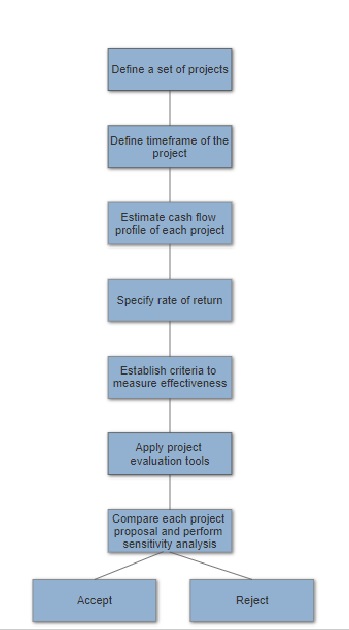Financial appraisal of project proposals
Contents |
Abstract
Generally, project managers have a difficulty in selecting the potential project proposals which give the best rewards for the company into their program or portfolio bounded by limited budget. One way to do this is to apply financial appraisal tools to evaluates the best investment bundle based on predicted costs and revenues which have been determined from either ground-up or top-down costing where input is estimated cost and competitive price respectively. The evaluation also depends on the size of the project and the time span over which the costs and benefits are going to be spread[1]. Usually, project managers take responsibility for two types of decision which are investment and financial decision. The investment decision is the decision that focuses on the concept of what to do in order to gain the maximum value, financial decision, however, related on how the projects should get the money from in order to run.
The aim of this article is to present techniques to make an accept or reject decision on investing project which are payback analysis, discounted cash flow, and internal rate of return which based on the concept of the “Time value of money”, and application of these tools also their limitations.
Time Value of Money
$1 of today is worth more than $1 of tomorrow
Time Value of Money (TVM) is the concept that money available today provide more benefit with the same amount than tomorrow. The reason is that on hand money today can be invested to generate more money in the future. To begin with, a basic knowledge of simple interest and compound interest must be manifested. The first interest perception is where the interest rate is calculated based on principal only and it is constant throughout the period, while compound interest is the other way round which calculated on the principal plus total amount of interest accumulated in the entire preceding period which makes the amount of interest increased over time. The example below is demonstrated to clarify the difference between these two interest.
Example: Given the rate of return of 10% per year and the principal of $100, what is the balance in the following four years.
Simple Interest: 
Compound Interest: 
Cost Estimation
Overview of cost estimation Cost estimation play an important role in every single project, when the project has been built, generally the managers always make a question about costs and revenues. In practice revenues can be generated with an ease by adding profit margin but not cost, since the complexity is huge that it contains several components depended on particular project. Typically cost can be distinguished in to two types namely direct cost that can be traced back to a cost object with less effort where cost object can be a product, department, project, to name but a few, for instance, direct labour cost, commission, and material cost. Indirect cost, however, is a reversed of direct cost where it cannot be accurately track to an exact cost object, examples of this cost are depreciation, insurance, electricity bill, and office space rental cost. As mention before, there are two aspects of specify a project cost; bottom-up costing and top-down costing.
Bottom-up costing – suite best when the market competition is less.
Top-down costing – work well when competition is high that it can limit cost component.
+++++++++++++++++++++++++++figure++++++++++++++++++++
Generally, there are several techniques to estimate cost of the project, asking an expert for the opinion and make a comparison to the situation is one of the magnificent estimators. Performing a quantitative method also the good way, techniques such as Cost Indexes, Cost Capacity Equations, Factor Method, and Activity Based Costing (ABC), where first three techniques can only comply direct cost but not ABC that can estimate both direct and indirect cost.
Financial Appraisal Tools
The propose of financial appraisal is to justify and select whether the return of the project is cover all the cost or minimize the loss, in case of public project such as construct a railway line which we know in advance that it is going to be loss but the project provides a social benefit that cannot measure by money. Throughout the procedure, cost and revenue of each project must be estimated by cost and revenue estimation techniques as mention above. After this, Minimum Attractive Rate of Return (MARR) is essential, project managers generally use an interest rate from financial institutions to determine this value. The document provides an overview of the following financial appraisal tools including example of each;
Present Worth Analysis
Annual Worth Analysis
Payback Period
Rate of Return Analysis
References
- ↑ Harvey Maylor (2010) 'Project Management'. Bath, United Kingdom: Pearson Education Limited
